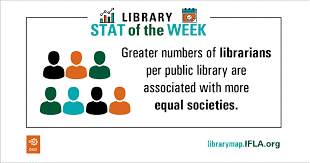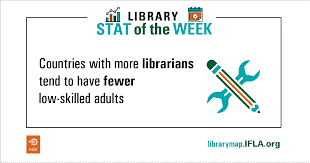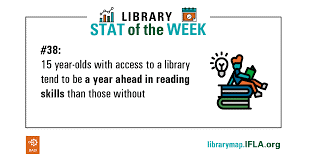Libraries are a great resource when it comes to learning, says Stephen Wyber of the International Federation of Library Associations and Institutions.

When we talk about infrastructure, we tend to think of roads, railways, cables and other physical networks crossing the landscape, enabling economic activity and growth. But the term can be extended to other areas that provide people with ways to achieve their goals, such as culture, research, and, of course, learning.
This blog looks at the last of these – the infrastructure for learning, throughout life. In particular, it considers the role of libraries both as providers of support and as partners and platforms for others, and looks at how to make the most of the unique characteristics of libraries as public, non-commercial, well-known and trusted community spaces.
A first key point to underline is how strong the library network is. Globally, there are at least 430,000 public and community libraries (one for every 16,000 people, for countries where we have data), millions of school libraries, and many other kinds of libraries all over the world. In effect, libraries are a pre-existing resource, ready and waiting to be engaged in efforts to support literacy throughout life.
A second is that they have an explicit mission to support education. This role is made clear in the Public Library Manifesto International Federation of Library Associations and Institutions (IFLA) and UNESCO, which underlines the mission of libraries to promote literacy and learning throughout life for all.
There are of course many great examples of this from the ground, showing what is possible. For example, IFLA’s Library Map of the World project provides access to examples of how libraries in different countries contribute to literacy goals, as well as to the wider United Nations’ Sustainable Development Goals.
However, this is not all that the Library Map of the World offers. It is also a key source of data that can help us understand better where we stand, and the trends and evolutions that are shaping the future. They can help us make comparisons, identify successes, and make connections. They are also critical in making an effective case for providing support to libraries. IFLA as an organization is therefore working hard to strengthen the availability of data about libraries.
To show the potential of the global library field, the Library Map of the World features all types of libraries, including national, academic, public, community, school, and special libraries. The initial set of performance metrics include number of libraries, number of libraries providing internet access, number of staff and volunteers, number of registered users and visitors, and number of loans. Reliable global library statistics is our shared vision and there’s already a huge amount of information available.
Thanks to this comprehensive data collection about libraries, we are beginning to be able to identify correlations, at the macro level, between libraries and literacy performance.
For example, we can show that:
- Where there are more public librarians, there are more adults involved in lifelong learning.
- Where young people have access to libraries, they score about a year ahead in their reading skills than those who don’t.
- Countries with higher adult literacy are, in general, characterised by a denser coverage of libraries, or in other words the smaller the population each individual public library needs to cover, the higher the literacy rate of the country.
- Children who are less advantaged – for example because they come from an immigrant or minority-language household, because they have fewer resources, or because their parents are not so highly educated, tend to rely more on libraries than do their better off peers.
Libraries have both the reach and the mission to support lifelong learning. The goal must be to try and realize this potential more widely.
IFLA is keen to help our members – associations, institutions – to contribute most effectively to the work of governments in promoting literacy everywhere. To do this – building on both the micro-level examples and the macro-level data – we are also working to identify examples of inclusion of libraries in national literacy and reading strategies.
Analysing global experiences, we can identify some interesting trends and innovative best practices around libraries and lifelong literacy that are already part of government policies:
- Governments
can engage libraries, alongside schools and community institutions, in both
planning and implementation of literacy and reading strategies. This way,
strategies can ensure full use is made of the possibilities that exist.
- Governments can see librarians as key actors in promoting literacy and give them the training they need. This can be a very cost-effective way of effectively engaging new literacy and reading promotors.
- Governments can ensure that libraries are able to provide services outside buildings, through mobile provision or through digital means. This is particularly important during the current pandemic, but it mattered before too, especially in countries with a less dense network of libraries.
- Governments can use libraries as one-stop-shops, where people can access all kinds of services while developing literacy skills, such as government services or support in finding a job.
- Governments can strengthen national library networks, which will mean that our institutions can better share resources and ideas efficiently. This will in turn help them be strong partners for national and local literacy initiatives.
Looking forward, I hope we can do more to understand and fulfil this potential. It would be particularly interesting to explore what works in ensuring the coordination of library activities for literacy with those led by others, such as schools, researchers and the lifelong learning community. Can we learn lessons?
Similarly, we need to explore to what extent a renewed focus on literacy serves to unify and strengthen library services, bringing wider benefits in terms of support for access to information more broadly.
Finally, and in the specific case of COVID-19 in particular, we have to ensure that libraries are not only connected themselves, but continue to help users to be able to get access to the materials, information, online resources and services they need in this specific situation. This includes providing access to computers and the internet and support in using them.
IFLA will continue to support the global library field with extensive information on how to best deal with the current pandemic by sharing information and global library practices, in the pursuit of making sure that communities are served in the best possible way with professional library and lifelong literacy services during these challenging times.
Stephen Wyber is the Manager, Policy and Advocacy, of IFLA, the International Federation of Library Associations and Institutions. IFLA is the leading international body representing the interests of library and information services and their users. It has joined the Global Alliance for Literacy as an Associate Member in 2020. Stephen’s blog is based on his intervention during the latest meeting of the Global Alliance for Literacy.




This is an awesome write up! I love it, because I can relate to it in its entirety. Well done!